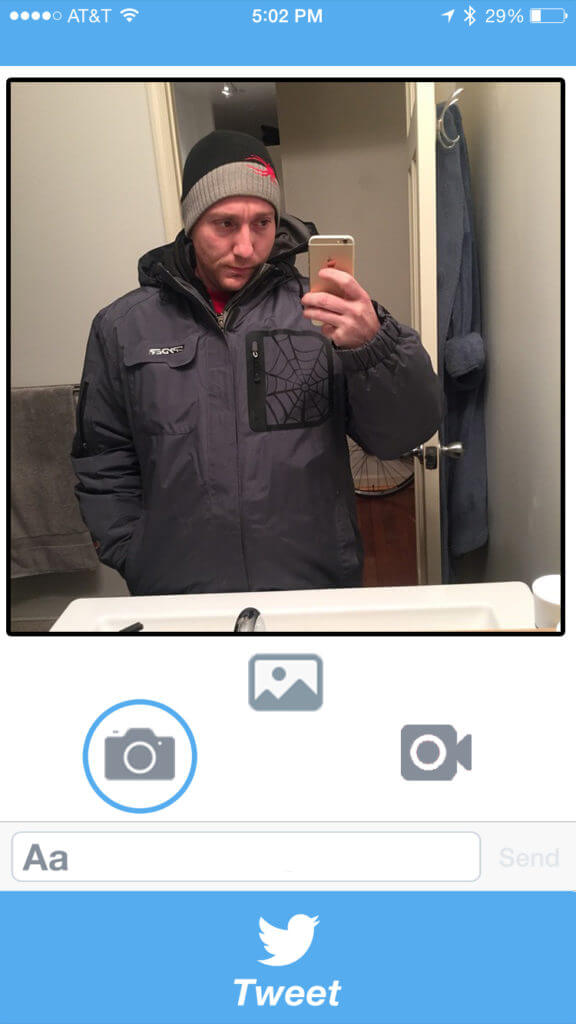For the TL;DR crowd: Be faster and build more apps, put in noise controls, build new offerings for businesses, but keep the original spirit and simplicity of Twitter.
Many people feel that we are in the final days Twitter. The death knell has been rung, and some are even writing eulogies….or did you think I’d be to stupid to know what a eugoogly is?
While I think the media coverage, investor pressure, and general speculation is part of what is driving that sentiment, it doesn’t change the fact that the idea is becoming more pervasive. It’s not unlike how the constant “it’s a ghost town” rumblings about Google+ may have colored how people looked at the network before even trying it.
That being said, Twitter is facing several “problems”
- Slowed user growth
- Flat, declining, or otherwise unimpressive revenue
- Flat or decreasing user engagement
I say “problems” but I think each problem is more concerning to Wall Street than anyone else.
I’ve also seen too many articles about Twitter disappointing Wall Street.
As an aside, why don’t we talk more about how Wall Street disappoints all of us?
Gary V famously said that Marketers ruin everything, but I’d say Wall Street is far worse.
But fear not, it is not too late!
Rethink | Redesign | Rebuild | Reorganize
I do not share the gloomy outlook.
I love Twitter. It has always been my favorite social site. Twitter embodies the spirit of social in a way that no other site can. It’s simple, public or private, open, anonymous or identified, searchable, and lends itself to meeting strangers and friends in the same place. So perhaps my optimism stems from my love of the platform.
The truth is most users don’t care about how many more million people are added to the platform and they certainly don’t care about Twitter’s ad revenue.
They care about where their friends are, they care about status and influence, they care about fun…they are there to be social.
So how do we fix it? How do we get the magic back?
Twitter must change with the times
Much of Twitter’s resistance to change certain things, is probably due to the die-hard Twitter loyalists (like myself) who remember the early days of the platform and who make a fuss over any proposed changes to our beloved platform. Additionally, it seems as though Twitter’s lack of diversity, combined with it’s new corporate, investor pleasing ways has left the product feeling a bit stale.
But I’ve come to realize that the site must adapt or it will perish, and I don’t want to live in a world where Social Media only means Facebook.
Tweet
We have to accept that to survive and thrive, Twitter needs to change. But that doesn’t mean it needs to lose its spirit or alienate its raving fans.
First we should acknowledge a few things:

- The site has fail whaled to update quickly enough.
- Most of Twitter’s efforts to court “normals” has fail whaled.
- Most users of Twitter do not tweet.
- Many accounts are old, spammy, or inactive.
- Twitter’s in-stream advertising–though the basis of Facebook’s advertising success–has not worked out particularly well for Twitter.
The site has lived this long because of celebrities, breaking news, and the small number of users (only a few percent) keep the content flowing through the home feed. Though Twitter is doing better than the 90-9-1 formula, it needs to do something to make the platform stickier to newbies and veterans alike.
Staying true while moving forward
As an early user, I fell in love with so much about the site. It’s imperative that as we “fix” or update the site, that we stay true to its roots.
It’s simple
- No complex privacy controls, it’s public or private (much like Instagram).
- Status updates have a structure: 140 characters (Update: Now 280)
- Public tweets are searchable
While Twitter may seem complex to the uninitiated, it remains a fairly simple concept that may just need to update its facade to appeal to a larger audience.
It’s real time
Twitter was the first to introduce the world to truly breaking news, as in, “I’m here right now live tweeting the event” type breaking news.
You can search what happened a second ago. Facebook still doesn’t have that, and only Snapchat is in the same conversation.
And let’s not forget, even though Facebook now has it, trending topics started on Twitter.
Facebook recently took trending topics and improved it. Twitter needs to get it back. I’ll explain more later. But what else…
It’s open and searchable
I love searching conversations in Twitter, it’s beautiful.
Whether searching for a phrase, a hashtag, or within a geographic radius, Twitter is the pulse of the internet, and it’s searchable.
It’s trustworthy
While Facebook has consistently and repeatedly violated user trust (among a long list of other incidents), Twitter has always been on our side. In the early days, I remember stories coming out in close timing with one another about Twitter refusing to hand over user data and private messages without a warrant, and Facebook changing previously private information to public.
Where Facebook generally treats its users as products, Twitter treated us as people.
Furthermore, WE built this platform, which is why WE are loyal to it.
And this is where I think Twitter has the advantage, if they can just move quickly and stop worrying about quarterly profits for just a bit.
The biggest threat to Facebook could be…Twitter!
Path is the Facebook-killer! Or no wait, it’s Diaspora? No, it’s Ello…Ello is the Facebook killer!
Who is going to unseat Facebook?
We’ve been speculating about a Facebook killer from the beginning of the Facebook era. While I don’t think Facebook is going anywhere, it doesn’t own the top spot, it just fights harder to keep it.
We’ve been looking everywhere for the next big thing, except maybe right in front of us.
Investors want Twitter to beat Facebook by becoming it, I’d suggest that the best way to beat Facebook is to just be a better Twitter that more people will use.
While many of the things I’m about to recommend may resemble Facebook, let’s not forget that each of these networks routinely steal from one another, and if we’re keeping count, Facebook would have nothing had it not stolen the idea of the newsfeed, trending topics, and in-stream ads from Twitter.
So, without further ado, here’s what I’d do/build if I was in charge of Twitter.
Step 1: Move FASTER and BUILD things
Twitter has been in a standstill for far too long. While tweets continue to rush through the pipes, something feels stale.
The app is not keeping up with other apps, the experience is not customizable, and some of the more obvious (to me at least) moves have not been made.
Twitter needs to move faster.
The app needs to be updated every week. New apps should be released.
The company needs new ideas and they need to build them quickly.
At the end of this post, I’ll post my suggested redesign of the primary app,
One Twitter app is cool, but…
You know what’s even cooler?
More Twitter apps, with specific functions.
At first I wasn’t sold on the multi-app strategy, but I’ve changed my mind as individual apps will do one thing better than the all-in-one apps, that do everything mediocre. Facebook has been quite successful with this strategy, and even Google to some extent.
Twitter needs a few new apps to augment the platform:
Twitter DM
Everyone is in the IM/text/messenger game. Now that Pinterest and Instagram have a messenger, one might think:
“…but why would should Twitter make a separate app?”
Well, when Google announced Chrome, people wondered the same thing:
“…why would Google make a web browser when we already have so many?”
Because maybe it can be done better.
People were freaked out when they read the Facebook Messenger terms of service. If Twitter can take the high road and make a great messenger with simple, straight forward terms, it might just give people a warm fuzzy feeling that they’re looking for.
Then, make a kick ass messenger.
Twitter should include
- Text chat (no character limit, emoji support)
- Picture chat with filters and text overlay
- Voice
- Live video
- Disappearing messages
For now, this is a “table stakes play,” but I, for one, would rather use Twitter messenger than FB messenger, Google Hangouts, WhatsApp, or anything besides iMessages/Text (which is still the most universal). Get in the game.
Tweet!
One app we are clearly missing is an app that has one purpose: to publish tweets as quickly as possible.
It should open immediately without a splash screen and go right into a selection of status update, or photo and video. If Twitter is going to stay real time, it needs to open and post, faster and faster.
This could be an app, and/or a widget in the iOS notification center, or an Android widget. Alternatively, they could just build this into the main app.
Frames (by Twitter)
Remember when Twitter launched their photos with filters? Most people don’t. But it’s pretty damn good, at least as good as Instagram.
Remember when Twitter launched 30 second videos? Most people don’t. But it’s a better length for business video than Instagram or Vine.
Twitter could easily go head-to-head with Instagram. I’m not saying they could “win” but they could build a great product that sits on the back of Twitter and I’m sure plenty of people would use that.
One of the big advantages that Instagram has is a headstart, but more importantly, that Instagram can be the originating point for the photo, meaning pictures from Instagram can be posted to Facebook, Twitter, Tumblr and Flickr.
Frames would be a standalone app, similar to Vine or Periscope, but it would integrate with Twitter for finding friends. Posts on Frames could be posted to Twitter, and Twitter images and videos could be posted to Frames.
#HashChat (Groups)
I used to love Twitter chats.
But Twitter got too noisy.
We need a place to put those pesky feed clogging chats. The app could be a self contained Twitter chat app.
Users could choose to share the tweets to their feed, or keep them in the group.
Groups/chats could be public or private.
Twitter Channel Guide
More on this later in the post.
Step 2: Change everything, but keep it the same
All roads flow through Twitter
Twitter, for me, has often been the feed of my life. My Instagram flows through it, my YouTube activity, my Tumblr blog, etc, etc.
It’s where I post everything to. But one thing it is not, is the place from which things flow from. More on this in a minute.
The wealth of data that Twitter has access to from being the place content is pushed to should not be taken for granted. Twitter presumably has access to what other social channels we’re using, and for a company struggling to sell advertising it seems odd not to use that as an opportunity to help brands cross sell their social channels.
Back to my earlier comment, Twitter could also be the place from which content originates. Much like how Instagram can be published to Facebook, Twitter, Tumblr, Flickr and others, Twitter has 30 second video, a great photo editor, and several other apps (periscope and vine), that could all benefit from extra exposure. When people click the link on Facebook, it could bring them back to Twitter.
Vine, Periscope, and Medium already naturally flow through Twitter, there’s no reason everything else can’t.
Twitter could become the newsfeed for the web. It’s where content ends up, and where it originates.
Still simple
The spirit of Twitter is rooted in simplicity. Though @mentions and #hashtags may not seem simple to a new user at first glance, the platform itself is much less complex that Facebook with its various privacy settings, applications, profiles, pages, groups, interest lists, friend lists, games, etc.
The next version of Twitter must remain simple. In fact, it needs to get even more simple.
Many have suggested that tweets need to be longer to stay relevant…I disagree.
Mobile
It shouldn’t have to be said, but mobile is EVERYTHING right now.
While the desktop experience is still important, the mobile experience must come FIRST.
If I were in charge, we’d leave the desktop alone until we have damn good mobile products.
Noise controls
Here’s what Facebook got right: the newsfeed algorithm. Breathe…let me explain.
I HATE the Facebook newsfeed algorithm. I HATE Facebook deciding FOR me what I should see. I want to choose.
BUT I will say this, the Facebook newsfeed is far easier to process than the Twitter home feed, which is pure chaos and, at this point, completely irrelevant.
I’m not saying Twitter should do the same, but they should learn the lesson: there is too much noise.
There are other ways to implement noise controls besides taking control out of the users’ hands and using an algorithm to decide on their behalf. Here’s some ideas…
Lists
I know I’ve been beating this drum for a while, but I still think the answer is in lists.
I know that the data shows that people don’t make lists, but I’m pretty sure that Pinterest would disagree since those pin boards are pretty much lists.
The problem is in how it is executed. Both Facebook and Twitter make it very difficult to make lists. Perhaps that’s why people don’t make lists. Facebook has always made it notoriously hard to make lists, and I would suggest that the reason is to drive you to the algorithmically run News Feed so they can show you what they want for either advertising or experiments.
And as an aside “lists” aren’t fun. Lists are for groceries, and tasks. Gah! No more. Let’s fix that, how about we call them “channels?” My TV has channels, YouTube has channels.
Channels have programming, lists have diapers.
If you look at how Hootsuite for iOS works, you can flip from channel to channel with ease.
Further, Twitter can get more into the curation game by creating a “marketplace” for channels. People can publish their curated lists for others to subscribe to. If you want to see a real life example of this, you needn’t look further than Robert Scoble, who curates some of the best lists on the internet.
Filters and Search
Lists are a form of filter. It allows you to see content from a selection of sources. But there are other filters that might be helpful too.
Wouldn’t it be great to see only the images or videos in your stream, or just the posts talking about a certain topic? What about filtering to only see what people post from Tumblr, or all the articles from the NY Times or WSJ.
It’s all possible.
All it takes is a search bar that’s always there…and guess what else, you can sell ads on those searches, JUST LIKE GOOGLE! This would open up an entirely new source of revenue, real time ads based on trending topics.
Clean up on aisle #2015
It’s a new day. Let’s get rid of all the accounts that haven’t been active since 2012. That doesn’t mean the accounts that haven’t tweeted, I mean the ones where people left and never came back. And it’s always someone that took a kick ass username and is just squatting on it.
Why is Twitter so reluctant to close these accounts and give back the awesome username? Is Twitter better off with 300 million users and a bunch of dead accounts, or cutting the dead weight and making room for the next wave of Twitterati?
Let’s kick out the spammers, the dead accounts, and the people who are just straight up shitty. It’ll help, and it’ll show the users that there’s a new sheriff in town, and this time we mean BUSINESS!
Step 3: Profit
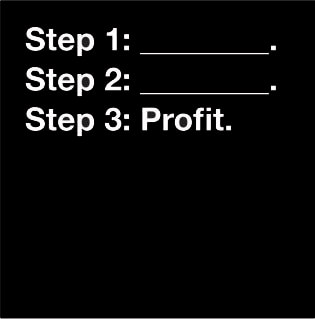
Let me reiterate that I’m no fan of advertising. I have long advocated that social sites think bigger than just advertising. That being said, there is a place for advertising and in the hands of a good marketer, it doesn’t have to be awful.
I’m going to suggest some advertising options for generating revenue, I’m also going to suggest a few non-advertising based ways of generating revenue.
Let’s start here…
Channel (Advertising)
Advertisers can buy ads to be shown in-stream inside of certain channels.
Advertisers would select the proper channel with a boolean search for channels with words that should and should not be in the title or description.
This would be a more targeted way of getting in front of the right people, than home stream ads.
Groups (Advertising and Membership)
The owner of the group/chat could set a price (within a set range) for brands to sponsor the chat for a period of time. Ad revenue is split between the group owner and Twitter.
Advertisers could find the right groups using a boolean search.
Access to private groups could also be monetized. Twitter could take a cut of.
Search (Advertising)
Remember how I suggested that there should be a persistent search bar at the top?
Each search is an opportunity to sell an ad. Google has done this for years, last I checked, they make money. This could open an entirely new opportunity, where brands buy ads around trending topics, and Twitter sells a notification service to brands to learn about when a keyword, hashtag, or phrase is trending.
Vine, Periscope and Frames (Advertising)
There’s no reason to wait anymore. Facebook has made it obvious that the vast majority of people are ok with some ads, so long as you keep the site free. While I’d rather use an ad blocker or pay to avoid ads, I can see why people would opt for ad supported.
My point is, there will be no mass exodus if ads are introduced on every platform as soon as there is an audience. It’s expected at this point and whatever site you start using instead, will likely soon have ads.
…but leave Medium alone, it’s so pretty without ads.
Marketing/Business Tools
Now, here are some of the non-advertising ways that Twitter can make money.
The most important thing to keep in mind here is that, much like on Facebook, it is the businesses that generate the revenue. Therefore Twitter needs to become a more attractive platform for business.
Verified Accounts
Application fee: $15 (I made up that number)
I’d probably pay Twitter to get verified, and so would tons of businesses, especially those that frequently get impersonated.
One of the things that Twitter brought to the table, was the ability for anyone to develop an audience and become a micro-celebrity. The first step on your way to becoming a celebrity would be to make sure that you own your identity/brand.
Direct Marketing
I’ve written about this before, but let’s dig deeper. Twitter could easily use Direct Messages to create their own Email Marketing-like system for businesses.
Imagine if the follow became the equivalent of the subscribe. Businesses could send mass Direct Messages to customers.
Businesses could see a dashboard, similar to what you see in Mailchimp or Constant Contact. Twitter could show open rates, clickthrough rates, and even build in a function where users could forward the direct message.
It’s like email marketing but in real time…similar to text (SMS) marketing but with better data.
Businesses could even create channels to segment their audience and selectively send to certain followers. Twitter could even offer user data about location, gender, or anything else on public profiles.
To opt-out followers would simply unfollow.
Simple and Effective. They could charge by number of followers or number of DMs sent.
Marketing Automation
Imagine Marketo or Eloqua for Twitter.
Interacting with a tweet could trigger an ad campaign.
Someone following you, could trigger a Twitter drip campaign.
It could all be measurable and automated. It just needs to be thought out and built. The precedent has already been set with email.
Advanced Analytics
There should also be at least basic analytics for each platform. Many businesses will pay a monthly subscription for good analytics. If the investment is being made to use the platform and create content for it, analytics are crucial for determining ROI.
Give marketers some good data, and they will likely pay for it. Give them great data and you can be almost sure of it.
And even more business tools
CRM integrations, advanced social listening dashboards, premium reporting…the list goes on and on!
Appendix A: Ch-Ch-Ch-Changes to the main app
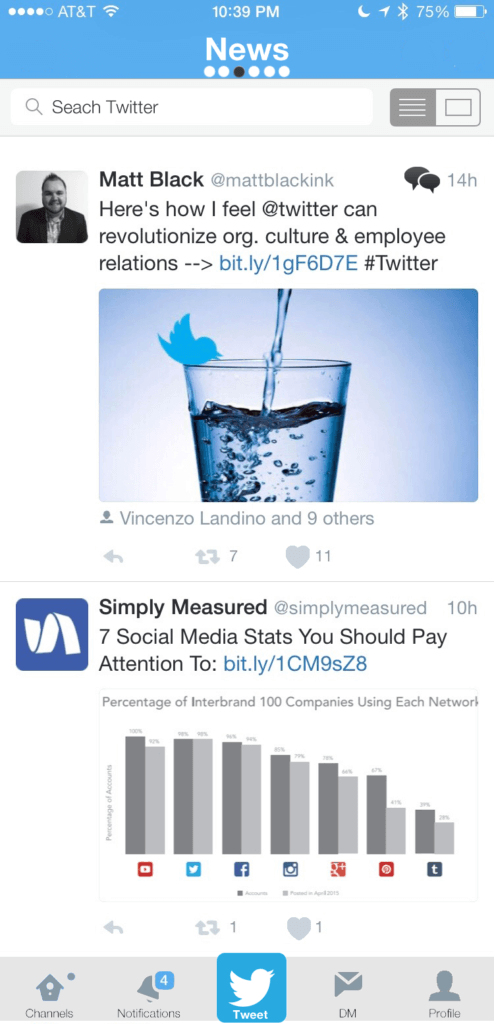
The Layout
- You’ll notice that the tweet button is prominently displayed in the middle on the bottom.
- On the left of the Tweet button will be notifications and Channels (which will replace the home button feed)
- On the right of the Tweet button are DMs and the Profile.
- The DM button will open the new Twitter DM app.
- The Profile will bring you to the new, more robust profile.
- Favorites (stars) will become Hearts <3 (which is being used on Periscope)
- Swiping right and left will move you from one channel to another.
- The search bar at the top allows for searching through all of Twitter, or within this channel. When a search is entered, there should be options to search all of twitter, or just within this channel.
- Each channel can be viewed normally, where all cards are expanded, or media-only, where only pictures, videos, Vines, and Periscope broadcasts will be loaded.
- A conversation bubble will denote a Tweet that has replies. Tapping this will go to a threaded conversation.
- Let business accounts boost Tweets right from within the app.
Tweeting
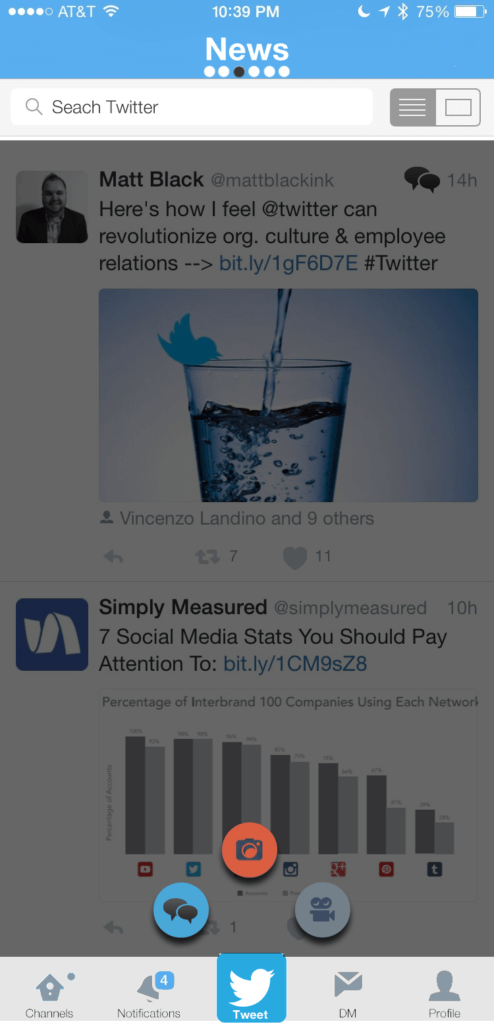
It should be faster and easier.
Pressing the Tweet button should present three options:
- Status
- Photo
- Video
Credit to Tumblr for those buttons in the mockup
Channels

The Home Stream should be replaced with different channels that people can customize however they want. Instead of following people, Twitter accounts are placed into different channels. The default channels are:
- Favorites (Limited to 20 accounts, Private by default)
- Friends (Limited to 150 accounts, Private by default)
- Acquaintances (Private by default)
- Influencers (Public by default)
- News (Public by default)
- Brands (Public by default)
- Celebrities (Public by default)
- Frames (for Twitter Frames)
- Everything (An aggregation of all channels, similar to the current home feed)
Additional custom channels can be created (like lists). People can create public channels or private channels. Public channels are automatically added to the new Twitter Channel Guide (see Appendix E).
Channels can also be added/followed from the new Twitter Channel Guide.
Groups can also be added to the channel guide from the new #HashChat app.
Channels would make it easier for people to use Twitter as their primary news source, but also give the ability to follow friends (assuming that these changes help people get more of their friends on Twitter).
Appendix B: Twitter DM
Twitter DM could be a bad ass straight forward messenger. A key element would be to include terms of service that did not include the shady shit they include in the FB messenger terms of service.
Forgive the quality of the mock ups, I’m not a designer, but I can throw together ideas quickly.
First, I’d suggest a messenger app without too much clutter. Just chats and settings. There would also need to be multiple account support like the Twitter app.
Next, for the messages view, give us the basics: text, photos (now), photos (from camera roll), video, and audio.
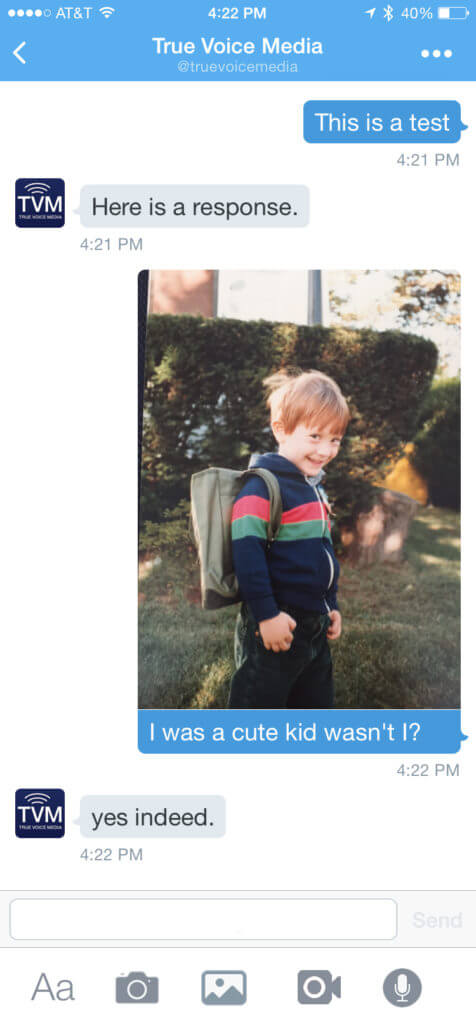
It doesn’t need to be crazy, just simple and straightforward, with a better privacy policy.
Appendix C: #HashChat
I didn’t have the time to fully design this app but here’s the basic gist: an app to separate out hashtag conversations and chats. Hashchats could be public or private. Private hashchats could be monetized by charging an entrance fee, or a monthly subscription. There should be a directory of hashchats in the channel guide (see Appendix E).
There should be an option to publish your tweets to your stream, or keep your hashtag related tweets in the hashchat.
Additionally, chats should be searchable and have the option to see everyone’s tweets, or only those in your network.
Conversations should be threaded with the ability to reply to any individual tweet or reply. This should mimic the Facebook threaded comments. It’s easier to follow than how chats currently work.
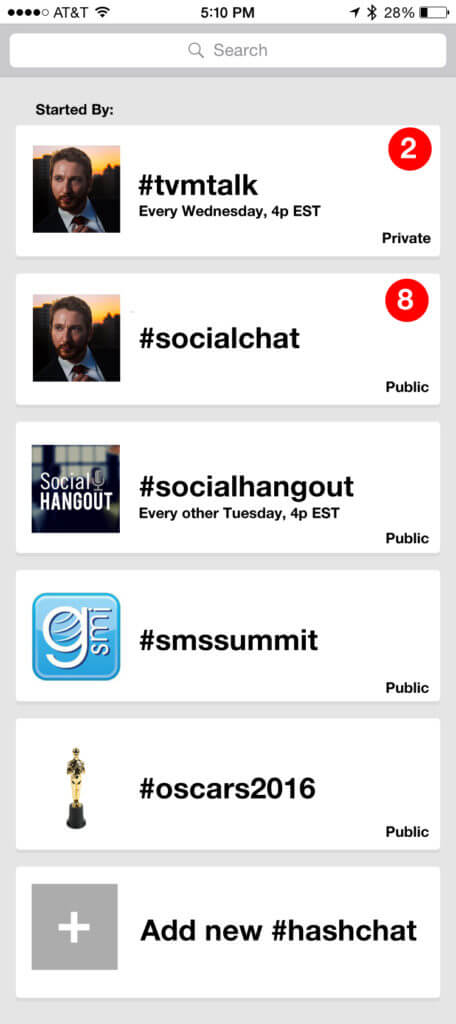
Appendix D: Tweet
I think Twitter needs an app built for speed. If Twitter wants to be real time, then they need a lightweight app that opens right to publishing. No splash screen, no selection process. Either start typing in the message box, tap the camera icon to take a picture (or several), tap the pictures icon to pull from the camera roll, or hold the video app to capture video up to 30 seconds at a time.
